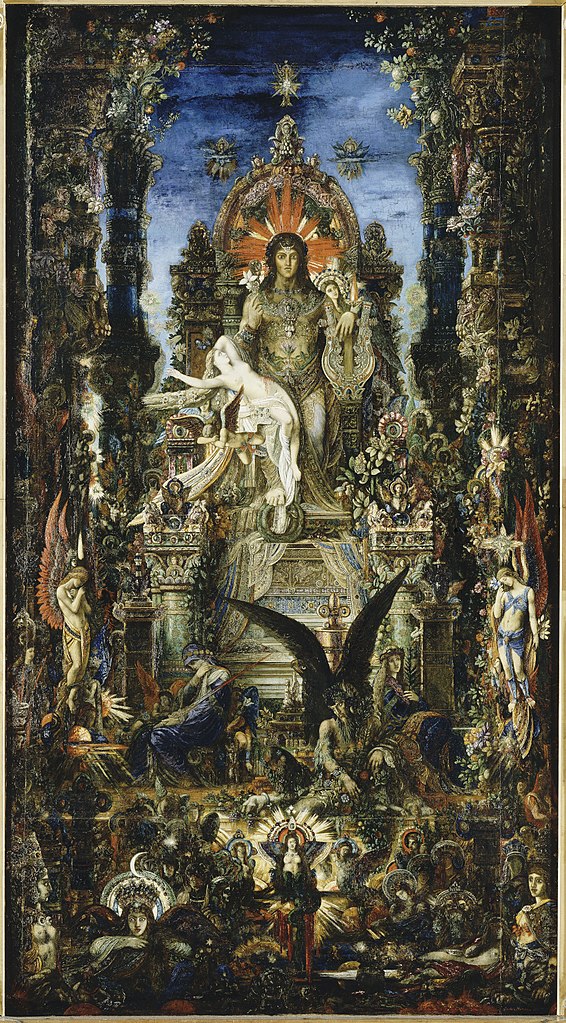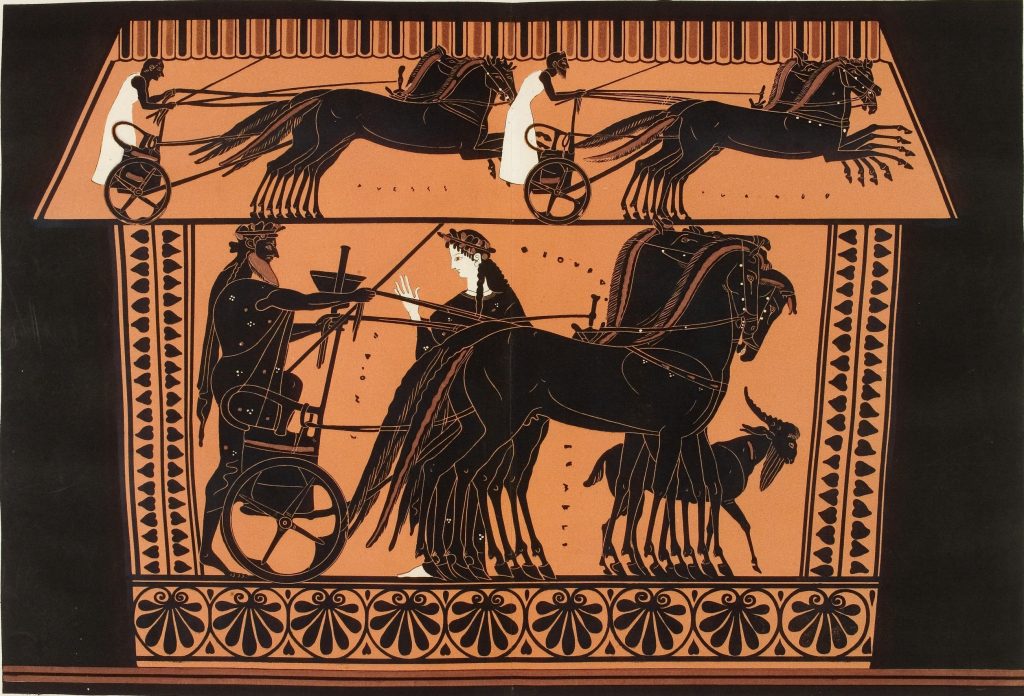Semele and Selene, one was born a mortal and the other a goddess. Both have enchanting and melodious names in ancient Greek with the same type of resonance. No wonder we sometimes confuse one for the other. However their stories are very dissimilar and poles apart.
Selene – also known as Menē in Pindar1 and in the Hymn to Selene2 – is a goddess and spends her days driving her golden or silver chariot; she may have wings and enjoys bathing in the ocean. There is also the mention of Selene as the mother of Pandia in the Homeric Hymn to Selene.
[1] And next, sweet voiced Muses, daughters of Zeus, well-skilled in song, tell of the long-winged Moon. From her immortal head a radiance is shown from heaven and embraces earth; and great is the beauty that ariseth [5] from her shining light. The air, unlit before, glows with the light of her golden crown, and her rays beam clear, whensoever bright Selene having bathed her lovely body in the waters of Ocean, and donned her far-gleaming raiment, and yoked her strong-necked, shining team, [10] drives on her long-maned horses at full speed, at eventime in the mid-month: then her great orbit is full and then her beams shine brightest as she increases. So she is a sure token and a sign to mortal men.
[15] Once the Son of Cronos was joined with her in love; and she conceived and bare a daughter Pandia, exceeding lovely amongst the deathless gods.
Hail, white-armed goddess, bright Selene, mild, bright-tressed queen! And now I will leave you and sing the glories of men half-divine, whose deeds minstrels, [20] the servants of the Muses, celebrate with lovely lips.
Homeric Hymn to Selene, translated by Hugh G. Evelyn-White

Selene is the moon goddess. She is cited in Hesiod3 as one of the gods and goddesses of “the holy race of all the other deathless ones that are for ever”. And she is praised and sung to by the Muses. Her epithet is “shining, brilliant, bright”. Another epithet used for her is “rich-tressed”. In Hesiodic poetry she is the daughter of Theia and Hyperion.
And Theia, overcome in the embrace of Hyperion, brought forth the great Sun, and bright Moon, and Dawn, that shines for all that-dwell-on-the-earth, and for immortal gods, who occupy the broad sky.
Hesiod Theogony 370–375
However, in the Homeric Hymn to Helios4 (the Sun), she is the daughter of Euryphaessa and Hyperion, and the sister of the Sun and of Eos. And yet, Euryphaessa might simply be an epithet of Theia.
Euryphaessa, the far-shining one, bare to the Son of Earth and starry Heaven. For Hyperion wedded glorious Euryphaessa, [5] his own sister, who bare him lovely children, rosy-armed Eos and rich-tressed Selene and tireless Helios who is like the deathless gods.
Homeric Hymn to Helios, translated by Hugh G. Evelyn-White

Semele herself is a mortal but she is the mother of Dionysus. Is she the only mortal to be the mother of a god? She was one of the many mortal women loved by Zeus. Her love affair too ended very badly. She was from Thebes, the daughter of Cadmus and Harmonia. At the time when Semele was pregnant, Hera, jealous as usual, convinced Semele to ask Zeus to reveal himself to her. As a result, however, Semele was consumed by fire after seeing him. Zeus saved the baby, Dionysos, by sewing him into his thigh. Another strange birth!
And to Cadmus were born daughters, Autonoe, Ino, Semele, Agave, and a son Polydorus. Ino was married to Athamas, Autonoe to Aristaeus, and Agave to Echion. [3] But Zeus loved Semele and bedded with her unknown to Hera. Now Zeus had agreed to do for her whatever she asked, and deceived by Hera she asked that he would come to her as he came when he was wooing Hera. Unable to refuse, Zeus came to her bridal chamber in a chariot, with lightnings and thunderings, and launched a thunderbolt. But Semele expired of fright, and Zeus, snatching the sixth-month abortive child from the fire, sewed it in his thigh. On the death of Semele the other daughters of Cadmus spread a report that Semele had bedded with a mortal man, and had falsely accused Zeus, and that therefore she had been blasted by thunder. But at the proper time Zeus undid the stitches and gave birth to Dionysus, and entrusted him to Hermes.
Apollodorus, Library 3.4, translation by Sir James George Frazer.5

She was brought back from Hades by her son, Dionysos, and was allowed to join the gods. She became immortal. Her son also became a god even though Semele was born a mortal.
Under the power of noble joys, malignant pain [20] is subdued and dies, whenever god-sent Fate lifts prosperity on high. This saying applies to the daughters of Cadmus on their lovely thrones: they suffered greatly, but their heavy sorrow collapsed in the presence of greater blessings. [25] Long-haired Semele, who died in the roar of the thunderbolt, lives among the Olympians; Pallas is her constant friend, and indeed so is father Zeus, and she is loved by her ivy-crowned son.
Pindar, Olympian 2, lines 20–29, translated by Diane Arnson Svarlien.6
In Theogony, lines 940–943, Hesiod7 mentions that Semele was a mortal, a mother of a god and became a goddess herself.
940 And to him Semele, daughter of Kadmos, bore an illustrious son, Dionysus bringer of joys, after union in love, mortal though she was, an immortal. But now both are deities.
Hesiod Theogony, 940–943, translated by J. Banks and adapted by G. Nagy
Homeric Hymn to Dionysus8 starts with the mention of Dionysus being the son of Semele, and the last lines again mention the mother by the name. Dionysus is often mentioned as the son of Semele, putting emphasis on his mortal mother.

About Dionysus son of most glorious Semele my mind will connect, how it was that he made an appearance [phainesthai] by the shore of the barren sea on a prominent headland, looking like a young man at the beginning of adolescence.
…..
Hail and take pleasure [khaire], [O Dionysus,] child of Semele with the beautiful looks. There is no way I could have my mind disconnect from you as I put together the beautiful cosmic order [kosmeîn] of my song.
Homeric Hymn to Dionysus lines 160, translated by Gregory Nagy
At the end, both women, Selene and Semele, one born into immortality and the other saved by her son, occupy the same household above.
Notes
1Pindar, Olympian 3.20: ἑσπέρας ὀφθαλμὸν ἀντέφλεξε Μήνα. Greek text from The Odes of Pindar including the Principal Fragments with an Introduction and an English Translation by Sir John Sandys, Litt.D., FBA. Cambridge, MA, Harvard University Press; London, William Heinemann Ltd. 1937.
Online at Perseus
2 Hymn 32 to Selene, line 17: χαῖρε, ἄνασσα, θεὰ λευκώλενε, δῖα Σελήνη. Greek text from The Homeric Hymns and Homerica with an English Translation by Hugh G. Evelyn-White. Cambridge, MA, Harvard University Press; London, William Heinemann Ltd. 1914.
Online at Perseus
3 Hesiodic Theogony, 1–115 translated by G. Nagy, 116–1022 translated by J. Banks and adapted by G. Nagy.
Online at the Center for Hellenic Studies
4 Hymn 31 to Helios. Translation from The Homeric Hymns and Homerica with an English Translation by Hugh G. Evelyn-White. Cambridge, MA, Harvard University Press; London, William Heinemann Ltd. 1914.
Online at Perseus
5 Apollodorus, The Library, with an English Translation by Sir James George Frazer, F.B.A., F.R.S. in 2 Volumes. Cambridge, MA, Harvard University Press; London, William Heinemann Ltd. 1921.
Online at Perseus
6 Odes. Pindar. Diane Arnson Svarlien. 1990.
Online at Perseus
7 Hesiodic Theogony, 1–115 translated by Gregory Nagy, 116–1022 translated by J. Banks and adapted by Gregory Nagy.
Online at the Center for Hellenic Studies
8Homeric Hymn to Dionysus, translated by Gregory Nagy
Online at the Center for Hellenic Studies
Image Credits
Selene: Musei Capitolini
Photo: Sailko, Creative Commons Attribution-Share Alike 3.0 Unported license, via Wikimedia Commons
Selene fights against the Giants
Photo: Miguel Hermoso Cuesta, Creative Commons Attribution-NonCommercial-ShareAlike 4.0 International (CC BY-NC-SA 4.0) license, via Wikimedia Commons
Jupiter and Semele, Gustave Moreau, Public domain, via Wikimedia Commons
Dionysus and Semele, Public domain, via Heidelberg Historic Literature- digitized
Images accessed March 2022
Hélène Emeriaud and Janet M. Ozsolak are members of Kosmos Society